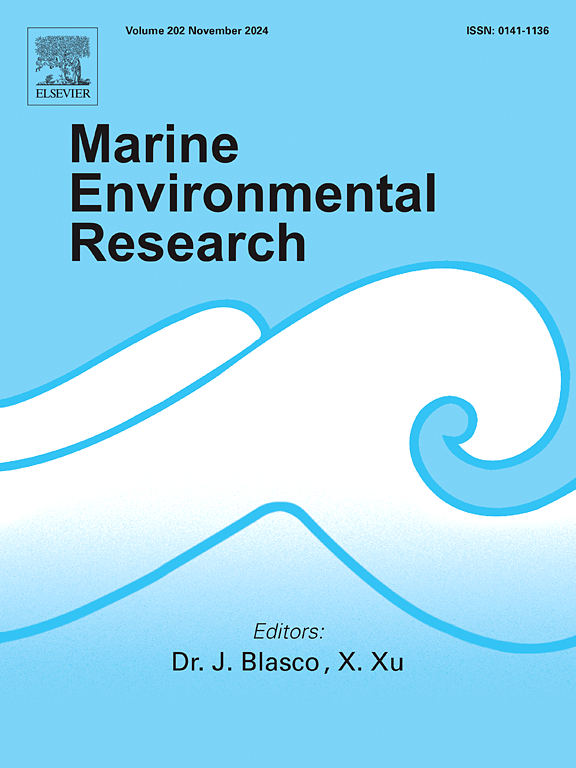Investigating adult reproduction as a potential barrier to recovery of wild Manila clam (Venerupis philippinarum) populations impacted by the Nathan E. Stewart oil spill, Central Coast, B.C.
IF 3
3区 环境科学与生态学
Q2 ENVIRONMENTAL SCIENCES
引用次数: 0
Abstract
Understanding the chronic effects of environmental disasters, such as oil spills, is critical to assessing long-term impacts on marine ecosystems and guiding recovery efforts. We assessed the reproductive potential of adult Manila clams (Venerupis philippinarum) from sites impacted by the Nathan E. Stewart oil spill (Central Coast, British Columbia, Haíɫzaqv Territory, October 2016) to determine if reduced reproductive capacity may be driving a delayed population recovery among the impacted clam populations. Clams from both reference and impacted sites were conditioned under controlled laboratory settings, with reproductive metrics (gonadosomatic index, progression of gamete development, fertilization success, spawning success) showing no significant differences between sites, suggesting that reproductive output in adults is not currently limiting recovery. Adult clams from all sites successfully spawned under controlled laboratory conditions. However, despite successful spawning and fertilization, larval survival was uniformly low across sites; this low survival may be attributable to methodological factors, such as temperature or handling stress rather than direct impacts of the oil spill. Findings suggest factors other than adult reproductive capacity are causing continued delay of population recovery, warranting further investigation.
调查受内森E.斯图尔特漏油事件影响的野生马尼拉蛤(Venerupis philippinarum)种群恢复的潜在障碍
了解环境灾害(如石油泄漏)的长期影响,对于评估对海洋生态系统的长期影响和指导恢复工作至关重要。我们评估了受Nathan E. Stewart漏油事件(2016年10月,不列颠哥伦比亚省中部海岸,Haí l zaqv领土)影响的成年马尼拉蛤(Venerupis philippinarum)的生殖潜力,以确定生殖能力的降低是否可能导致受影响蛤种群的延迟恢复。来自参考和受影响地点的蛤蜊在受控的实验室环境下进行调节,生殖指标(性腺指数,配子发育进展,受精成功率,产卵成功率)在不同地点之间没有显着差异,这表明成虫的生殖输出目前并未限制恢复。所有地点的成年蛤都在受控的实验室条件下成功产卵。然而,尽管成功产卵和受精,幼虫存活率在各个地点都很低;这种低存活率可能归因于方法因素,如温度或处理压力,而不是石油泄漏的直接影响。调查结果表明,除成人生殖能力以外的其他因素正在造成人口恢复的持续延迟,需要进一步调查。
本文章由计算机程序翻译,如有差异,请以英文原文为准。
求助全文
约1分钟内获得全文
求助全文
来源期刊

Marine environmental research
环境科学-毒理学
CiteScore
5.90
自引率
3.00%
发文量
217
审稿时长
46 days
期刊介绍:
Marine Environmental Research publishes original research papers on chemical, physical, and biological interactions in the oceans and coastal waters. The journal serves as a forum for new information on biology, chemistry, and toxicology and syntheses that advance understanding of marine environmental processes.
Submission of multidisciplinary studies is encouraged. Studies that utilize experimental approaches to clarify the roles of anthropogenic and natural causes of changes in marine ecosystems are especially welcome, as are those studies that represent new developments of a theoretical or conceptual aspect of marine science. All papers published in this journal are reviewed by qualified peers prior to acceptance and publication. Examples of topics considered to be appropriate for the journal include, but are not limited to, the following:
– The extent, persistence, and consequences of change and the recovery from such change in natural marine systems
– The biochemical, physiological, and ecological consequences of contaminants to marine organisms and ecosystems
– The biogeochemistry of naturally occurring and anthropogenic substances
– Models that describe and predict the above processes
– Monitoring studies, to the extent that their results provide new information on functional processes
– Methodological papers describing improved quantitative techniques for the marine sciences.
 求助内容:
求助内容: 应助结果提醒方式:
应助结果提醒方式:


